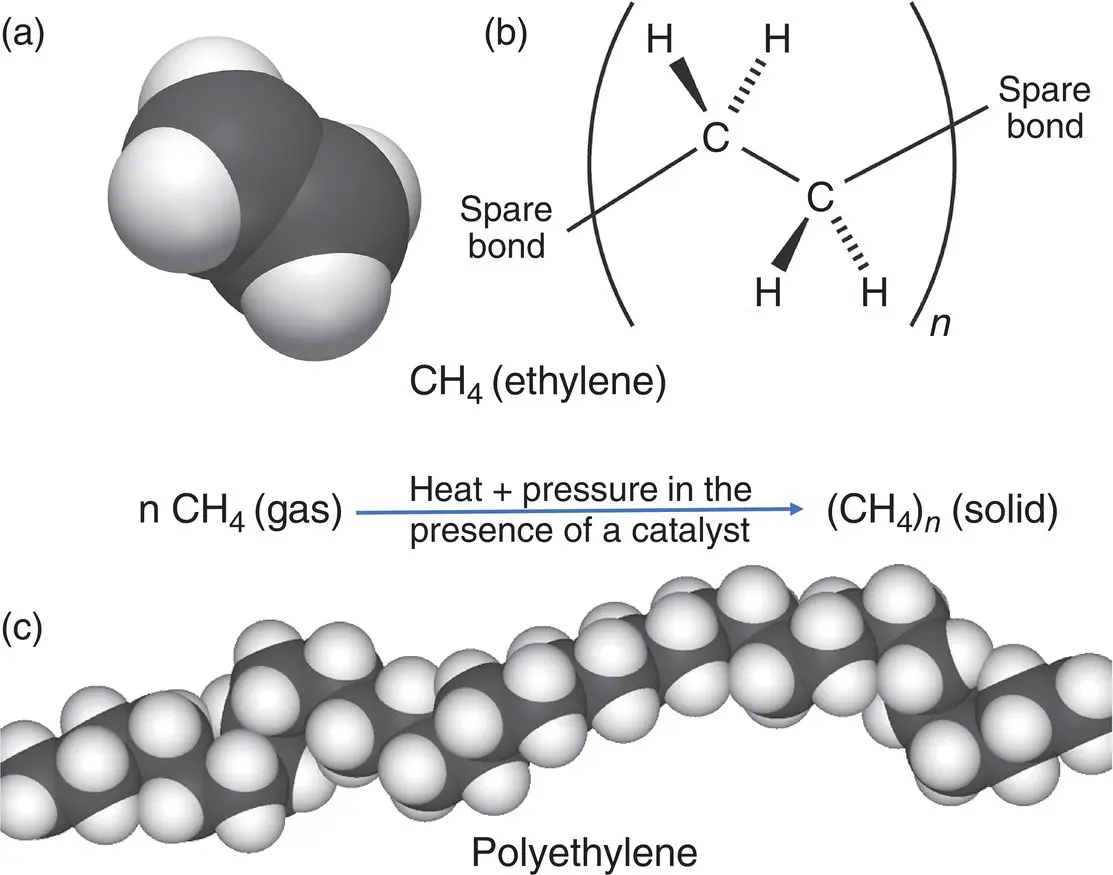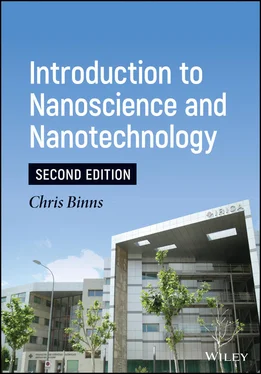2.7.2 Conversion of Waste Plastics to High‐Grade Materials (Upcycling)
Plastic is a polymer of small hydrocarbons like the CH 4(ethylene) molecule shown in Figure 2.18a. The molecule has two spare bonds ready to combine with the spare bonds from other CH 4molecules and heating ethylene gas at high pressure causes the molecules to form long chains (polymerize) of polyethylene (or polythene) as illustrated in Figure 2.18c. Modern plastics contain thousands to millions of molecules in the polymer chain. Polyethylene was first discovered accidentally in 1898 but was not produced commercially until 1939, though this was interrupted by the second world war when the process was kept secret. In the 1950s the introduction of catalysts enabled production at much lower temperatures and pressures producing a significant decrease in cost and the modern plastics industry emerged. Catalysts were briefly introduced in Chapter 1, Section 1.4and their role is to provide a surface whose chemical properties reduce the energy required for a specific reaction between two other species to occur. Since it is only surface atoms that contribute, all catalysts are in the form of nanoparticles in order to maximize the surface area presented per gram of material.

Figure 2.18 Polymerization of ethylene to produce polyethylene.(a) Ethylene CH 4molecule consisting of two carbon and four hydrogen atoms. (b) Bonding in CH 4showing two spare bonds for linking to other CH 4molecules. (c) Heating the ethylene gas at high pressure in the presence of a catalyst produces polyethylene.
The properties of the solid polymer are highly controllable by changing the chain length, introducing other atoms and branching the polymer chains. This happens naturally to some extent and can be encouraged to form a low‐density light material (LDPE) or discouraged, which allows the linear chains to pack tightly and form a high‐density strong material (HDPE). This controllability coupled with the low cost of production has made plastic something of a wonder material that has become ubiquitous in modern society. Currently, around 400 million tons of plastic are produced every year by manufacturers and 75% of this goes into single‐use products.
The waste plastic has now become an environmental problem filling landfill sites and a significant proportion ending up permanently trapped in large scale circulating currents in the oceans known as gyres . The problem is amplified by the fact that plastic does not biodegrade and material that was produced half a century ago is still lingering as waste. Recycling plastic is thus a high priority but simple recycling, which consists of melting plastic products produces a lower grade, lower‐value product (termed downcycling ) that is weaker than the original polymer. In practice, plastic can only be downcycled two or three times before it becomes unusable.

Figure 2.19 Catalyst for upscaling waste plastic.(a) Pt particles with a diameter of 2 nm on 100 nm SrTiO 3cuboids used as a catalyst for upcycling polyethylene. The inset shows the size distribution of the Pt nanoparticles. (b) Single SrTiO 3cuboid with its supported Pt nanoparticles. (c) Zoom in on red area in (b) showing the Pt nanoparticles in more detail. Also visible is the crystal lattice of the SrTiO 3.
Source : Reproduced with the permission of the American Chemical Society from [29].
Recycling would be much more attractive if the waste plastic could be converted to higher‐value products (a process known as upcycling ) such as lubricating oils and waxes that can be further processed into detergents and cosmetics. Converting waste plastics to other useful materials involves breaking carbon–carbon bonds to produce shorter chain molecules with a small mass distribution and this usually involves heating the plastic in the presence of hydrogen and a suitable catalyst, which is in the form of metal nanoparticles. Recently the catalyst shown in Figure 2.19, which consists of a combination of two nanostructures, was tested on a range of plastics [29]. The substrate consisted of 65 nm cuboids of strontium titanate (SrTiO 3), which is a highly crystalline material that has very good stability at high temperatures. Onto the cuboids was deposited 2 nm diameter platinum nanoparticles by a process known as chemical vapor deposition (CVD – see Chapter 5, Section 5.1.12). The catalyst was tested on a range of plastics ranging from high‐grade polyethylene to a single‐use plastic bag and in all cases was able to convert the complex branched high‐mass polymer molecules in the plastic to shorter linear molecules with a small mass range.
Other recent innovations in upcycling have been to use waste plastic feedstock to produce carbon nanotubes and graphene [30, 31]. These materials are described in Chapters 3and 4and are destined to find applications in a range of emerging nanotechnologies described in those chapters. The processes to extract them from waste are described in Chapter 5, Section 5.1.12. Producing such a high‐value product from waste plastic is a further step toward encouraging recycling.
This chapter has by far the widest scope in this book and each topic introduced here could easily occupy a book of its own. The treatment, therefore, has necessarily been superficial but a number of references are given for a more in‐depth study of various topics. The aim has been to give a flavor of the importance of nanoparticles in shaping our environment and also in addressing environmental issues. In the next chapter, we will bring our attention back to the research laboratory and discuss the fascinating world of carbon nanoparticles.
1 1 In a volcanic eruption most of the mass of volcanic ash is distributed in particles with sizes in the range 1 μm–1 mm and the plume reaches a height of up to 20 km. Assuming a prevailing wind with an average speed of 10 ms−1. Use the equation in Advanced Reading Box 2.1to calculate the maximum distance downwind of the volcano at which 1 mm diameter particles and 50 μm diameter particles are deposited. What size of particle can be expected to be deposited over the entire globe?
2 2 The table and graph below show the aerosol concentration in mg/m3 as a function of particle diameter measured in a typical urban environment. Assuming the average density of the material in the particles is 2000 kg/m3, convert the data to show the number of particles per cubic meter as a function of particle diameter.Particle diameter (μm)Mass per unit volume (mg/m3)0.011.00E−050.028.00E−040.030.0050.040.0070.050.0080.060.010.070.0110.080.0120.090.0140.10.0160.20.0290.30.0370.40.0470.50.0590.60.0650.70.0680.80.0690.90.06910.06820.0630.0540.06550.07860.08670.09180.09590.098100.1200.091300.072400.055500.04
3 3 Derive Equation (2.4)in Advanced Reading Box 2.2by considering the change in the energy of the surface tension of a liquid drop of radius r due to the shrinkage resulting from the evaporation of a single molecule of volume v.
4 4 Describe how phytoplankton produces an important feedback mechanism that helps to reduce global warming.
1 1 Schüler, D. (2002). The biomineralisation of magnetosomes in Magnetospirillium gryphiswaldense. International Microbiology5: 209–214. https://doi.org/10.1007/s10123‐002‐0086‐8.
Читать дальше














